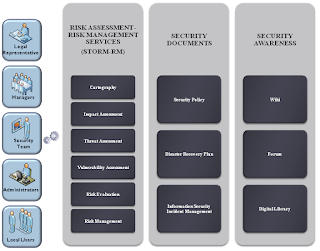Explanation of Cybersecurity and How to Properly Integrate it into Your Organization
9 Steps to Cybersecurity from expert Dejan Kosutic is a free eBook designed specifically to take you through all cybersecurity basics in an easy-to-understand and easy-to-digest format.
You will learn how to plan cybersecurity implementation from top-level management perspective. Additionally, Kosutic covers all of your options and how to choose the ones that ultimately will work best.
President Obama issued “Executive Order - Improving Critical Infrastructure Cybersecurity" on February 12, 2013. 9 Steps to Cybersecurity will inform you of what you need to know at this timely and critical juncture. The goal of this book is to give you the essential information you need to make decisions that are crucial for the future of your organization. Simply fill out the short form on the right-hand side of the screen to download 9 Steps to Cybersecurity today.
Why is this Book Essential for You?
Who Should Read this Timely, Free eBook on Cybersecurity?
Anyone interested in the cutting edge of cybersecurity and what is necessary to secure information should download 9 Steps to Cybersecurity, which can be read in less than 2 hours. This free eBook will be of tremendous interest to any executives wishing to be well versed in the latest cyber safety information. CEOs, CFOs, Chief Information Security Officers and other managers will find this detailed and informative examination of the current state of cybersecurity to be a must-read book. Additionally, 9 Steps to Cybersecurity is written in completely non-technical language - Kosutic's goal was for the book to be easily accessible to all executives, regardless of whether they have technical knowledge.
Once you’ve read Dejan Kosutic's book, you will have a clear concept of cybersecurity, and the direction that your company should take. You will be able to properly implement cybersecurity and comply with the regulations and relevant deadlines. 9 Steps to Cybersecurity was specifically written to provide much-needed clarity and help you chart the most direct and most effective path for your company, period.
Download this free book today and go well beyond the jargon and the confusion.
9 Steps to Cybersecurity from expert Dejan Kosutic is a free eBook designed specifically to take you through all cybersecurity basics in an easy-to-understand and easy-to-digest format.
You will learn how to plan cybersecurity implementation from top-level management perspective. Additionally, Kosutic covers all of your options and how to choose the ones that ultimately will work best.
President Obama issued “Executive Order - Improving Critical Infrastructure Cybersecurity" on February 12, 2013. 9 Steps to Cybersecurity will inform you of what you need to know at this timely and critical juncture. The goal of this book is to give you the essential information you need to make decisions that are crucial for the future of your organization. Simply fill out the short form on the right-hand side of the screen to download 9 Steps to Cybersecurity today.
Why is this Book Essential for You?
- Learn how to use risk management to make your cybersecurity a profitable investment
- Find out how cybersecurity can give your company an invaluable marketing edge
- Learn how to comply with various information security laws and regulations, including U.S. Executive Order - Improving Critical Infrastructure Cybersecurity Discover the invaluable tips for persuading upper management to act immediately
- Uncover the key elements of the CIA triad (Confidentiality, Integrity and Availability) and why it is vital to your company
- Learn everything you need to know in order to develop a cybersecurity plan and monitor the implementation by setting measurable targets
Who Should Read this Timely, Free eBook on Cybersecurity?
Anyone interested in the cutting edge of cybersecurity and what is necessary to secure information should download 9 Steps to Cybersecurity, which can be read in less than 2 hours. This free eBook will be of tremendous interest to any executives wishing to be well versed in the latest cyber safety information. CEOs, CFOs, Chief Information Security Officers and other managers will find this detailed and informative examination of the current state of cybersecurity to be a must-read book. Additionally, 9 Steps to Cybersecurity is written in completely non-technical language - Kosutic's goal was for the book to be easily accessible to all executives, regardless of whether they have technical knowledge.
Once you’ve read Dejan Kosutic's book, you will have a clear concept of cybersecurity, and the direction that your company should take. You will be able to properly implement cybersecurity and comply with the regulations and relevant deadlines. 9 Steps to Cybersecurity was specifically written to provide much-needed clarity and help you chart the most direct and most effective path for your company, period.
Download this free book today and go well beyond the jargon and the confusion.


